Difference between revisions of "Ikoflex Ib"
Hanskerensky (talk | contribs) (Added reference to McKeowns) |
Hanskerensky (talk | contribs) (Added reference to weight measurement) |
||
| Line 47: | Line 47: | ||
The Ikoflex 1b has an all metal, black painted body with black leatherette coverings. | The Ikoflex 1b has an all metal, black painted body with black leatherette coverings. | ||
| − | The tripod mount thread is 1/4 inch. The camera has a weight (without film) of approx. 1035 grams. | + | The tripod mount thread is 1/4 inch. The camera has a weight (without film) of approx. 1035 grams<ref> Measured on a Novar-Anastigmat equiped Ikoflex 1b </ref>. |
Revision as of 19:12, 19 January 2013

|
| 1b with 1:3.5 Novar-Anastigmat Lens image by Hans Kerensky (Image rights) |
The "Ikoflex 1b" is a model in a long line of Ikoflexes which started in 1934 and ended in 1960. It was produced by Zeiss Ikon in Germany from 1956 till 1958[1] as type number 856/16.
It is a medium format TLR for 120 type Rollfilm.
The taking lens is either a Zeiss Tessar or Novar-Anastigmat. Both having an aperture of 1:3.5 and focal length of 75mm and are coated. The viewing lens is a Teronar-Anastigmat with the same aperture and focal length as the taking lens.
The shutter is a Prontor-SVS. A leafshutter with a rim-set speedrange (in steps) from 1 till 1/300 second + B. The shutter has to be manually cocked before every exposure.
It has a V-X-M switch for self-timer (V) and X or M Flash synchronisation.
The shutter is released by a knob on the rightside of the body which can be swiveled inwards for protection during transport. Right next to the hood there is also a provision for a cable release.
The diaphragma can be set from 3.5 till 16 with a lever on the side of the shutter.
Focusing is done by moving the whole lensboard. The focusknob is on the leftside of the camera. Focus range is from 1 meter till infinity. The focusknob also has a DOF scale.
The waist-level viewing hood opens and closes in a single action. The image from the taking lens is reflected by a mirror onto a ground glass screen. The hood has a foldable magnifying-glass and also an eye-level sportsfinder.
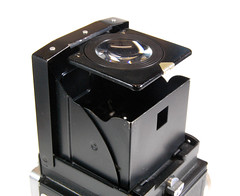
|
| Ikoflex 1b Viewing Hood image by Hans Kerensky (Image rights) |
Zeiss Ikon sold an optional prismatic viewfinder which can be clamped on the opened hood for an unmirrored eye-level view.
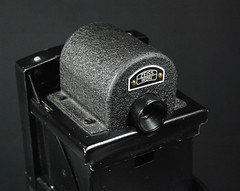
|
| Ikoflex Prismatic Viewfinder image by Hans Kerensky (Image rights) |
Filmtransport is done by first advancing the film till the framenumber 1 is visible through the red window in the bottom of the Ikoflex. After that the counter has to be reset by pressing and rotating a pushbutton, on the right side of the camera, till the nr 1 appears in the counterwindow above it. Only then the shutter release can be activated (double exposure prevention). After each exposure the film has to be transported by a winderknob on the right side till the transport blocks again.
The image format is 6x6cm giving a total of 12 exposures on a type 120 rollfilm.
The filmtransportknob sports a film memo disc.
The Ikoflex 1b has an all metal, black painted body with black leatherette coverings. The tripod mount thread is 1/4 inch. The camera has a weight (without film) of approx. 1035 grams[2].
Contents
More images
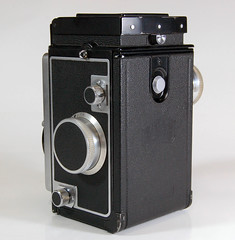 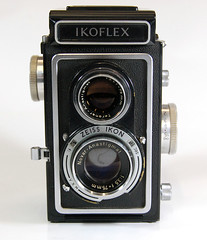 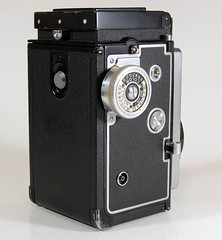
|
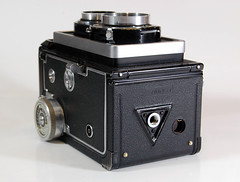 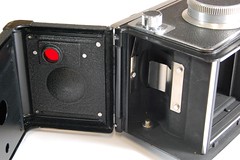 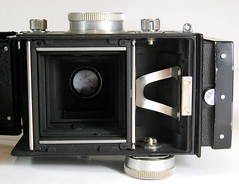
|
| Zeiss Ikon Ikoflex 1b, Zeiss Novar-Anastigmat f3.5/75mm lens. Images by Hans Kerensky. (Image rights) |
References
- ↑ McKeown, James M. and Joan C. McKeown's Price Guide to Antique and Classic Cameras, 12th Edition, 2005-2006. USA, Centennial Photo Service, 2004. ISBN 0-931838-40-1 (hardcover). ISBN 0-931838-41-X (softcover). p1051.
- ↑ Measured on a Novar-Anastigmat equiped Ikoflex 1b
Bibliography